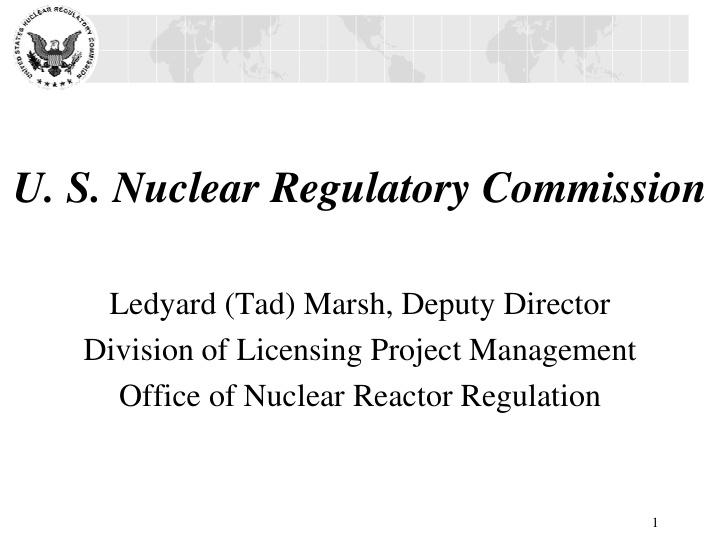



U. S. Nuclear Regulatory Commission Ledyard (Tad) Marsh, Deputy Director Division of Licensing Project Management Office of Nuclear Reactor Regulation 1
Overview of NRR… Who we are What we do How we accomplish our mission Power Uprate program Conclusion 2
Who we are… Located at Headquarters in Rockville, Maryland Legislatively mandated - Atomic Energy Act (1974*) Engineers, Scientists, Project Managers, Risk Analysts, Financial Analysts, Administrative staff One of the major program offices at NRC (about 600 of the 2800 staff) 3
What we do…. Ensure safe operation of: 103 power reactors Research / Test reactors Decommissioned reactors Review new Reactor Designs Develop & oversee Reactor inspection program Review operating plants’ applications for life extension (e.g. License Renewal) Review applications for changes to plant licenses (e.g. Power Uprates) 4
How we accomplish our mission Develop, implement and keep current regulations, safety standards, and regulatory guidance Perform operating reactor licensing and technical reviews Assess operational events and take needed actions (generic or plant specific; immediate or long term) Perform independent technical analyses Work with Regions to assess licensee performance and take appropriate actions 5
Power Uprate Program Mohammed A. Shuaibi Senior Project Manager Division of Licensing Project Management Office of Nuclear Reactor Regulation 6
Overview What is a Power Uprate? How is a Power Uprate Achieved? Types of Power Uprates Approved Power Uprates Review Process for Power Uprates Public Involvement Scope of Technical Review Review Guidance Review Effort Additional Assurance 7
What is a Power Uprate? The process of increasing the licensed power level at a commercial nuclear power plant allowing the plant to generate more electricity. 8
How is a Power Uprate Achieved? 9
Types of Power Uprates Measurement Uncertainty Recapture Power Uprates Stretch Power Uprates Extended Power Uprates 10
Approved Power Uprates 100 Total Approved 80 60 40 20 0 1 1 1 1 1 2 9 9 9 9 9 0 7 8 8 9 9 0 6 1 6 1 6 1 - - - - - - 1 1 1 1 2 P 9 9 9 9 0 r 8 8 9 9 0 e 0 5 0 5 0 s e n t Year Stretch Power Uprates Measurement Uncertainty Recapture Power Uprates Extended Power Uprates 11
Extended Power Uprates at Boiling-Water Reactors Monticello – 6.3% Hatch 1 and 2 – 8% Duane Arnold – 15.3% Dresden 2 and 3 – 17% Quad Cities 1 and 2 – 17.8% Clinton – 20% Brunswick 1 and 2 – 15% 12
Review Process License Amendment Process Normal Process Additional Steps for Extended Power Uprates Special Public Notice - More Emphasis on External Involvement Environmental Assessment Advisory Committee on Reactor Safeguards Higher Level Management Review and Approval Inspection by Region-Based Qualified Inspectors 13
Public Awareness & Involvement Public Notices Documentation Meetings and Workshops Draft Environmental Assessment Advisory Committee on Reactor Safeguards Meetings 14
Scope of Technical Review Civil Engineering Environmental Considerations Mechanical Engineering Human Performance & Training Maintenance and Testing Chemical Engineering Occupational Health Physics Piping Integrity Radiological Consequences Vessel and Internals Integrity Containment Performance System/Component Capabilities Balance-of-Plant Systems Spent Fuel Pool Fire Protection Instrumentation & Controls Reactor Core/Fuel Performance Electrical Engineering Transient & Accident Analyses Environmental Qualification Erosion/Corrosion Probabilistic Risk Assessment 15
Flow-Accelerated Corrosion Increased Flow Rates Higher Wear Rate Review by Flow-Accelerated Corrosion Experts Prediction of Erosion Rates Programs for Maintaining Piping in Safe Condition Detailed Guidance in Review Standard 16
Testing and Power Ascension Modifications Need for Testing New Operating Conditions Need for Monitoring Approach to New Conditions Reviewed by Maintenance and Testing Experts Testing of Modifications Power Ascension Program • Slow, Careful, Deliberate Monitoring of Important Parameters Detailed Guidance in Review Standard 17
Comprehensive Review Guidance Standard Review Plan Review Standard for Extended Power Uprates General Electric Topical Reports Experience with Past Power Uprate Reviews 18
Review Effort Large Effort 17 Technical Groups – Multiple Reviewers Per Group About 4000 Staff-Hours (Typical Licensing Action ~ 80 hours) 100 – 200 Questions (Requests for Additional Information) Methods of Review Review of Information Submitted and Other Material Audits of Licensee and Contractor Calculations and Programs Independent Calculations Requests for Additional Information Previous Experience with Plant-Specific Power Uprates and Generic Topical Reports 19
Power Uprate Information Available at NRC’s Public Website http://www.nrc.gov/reactors/operating/licensing/power-uprates.html 20
Closing Remarks… Power Uprate amendments are among the Most Significant Licensing Actions Intrusive and Comprehensive Review Effort Senior Management Oversight - from the top! Advisory Committee on Reactor Safeguards Public Involvement 21
Recommend
More recommend